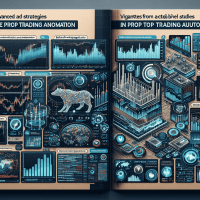Proven Prop Trading Automation: Expert Strategies
In today’s fast-paced financial markets, prop trading automation has become critical for traders and firms seeking to optimize performance, reduce risk, and deploy advanced strategies. This comprehensive guide explores cutting-edge automated trading systems, advanced backtesting techniques, and critical insights into how leading firms leverage technology to gain a competitive edge.
Understanding Prop Trading Automation
Prop trading automation involves using algorithm-driven systems to conduct trading activities without constant human intervention. This approach not only streamlines operations but ensures that backtesting, risk management, and strategy deployment occur efficiently. In this article, we dive deep into the mechanics of automation, detail key benefits, and provide expert guidance tailored for prop trading professionals at every level.
Key Benefits for Prop Traders
- Efficiency: Automated systems process vast data sets faster than manual efforts.
- Risk Management: Backtesting and real-time integration allow for precise risk calculations, including metrics like Sharpe Ratio and drawdown limits.
- Scalability: Automation systems can be scaled for team-based environments, essential for prop firms and trading desks.
- Consistency: Algorithms eliminate emotional bias, enforcing a disciplined trading approach.

Figure 1: Automated trading dashboard showcasing backtesting reports and key metrics like Sharpe Ratio and maximum drawdown.
Advanced Backtesting Techniques for Prop Trading
Backtesting is the cornerstone of any automated trading system. It involves simulating trading strategies using historical data to gauge potential performance. However, the process is fraught with challenges such as overfitting and survivorship bias. Here, we outline strategies to mitigate these pitfalls while leveraging sophisticated backtesting methodologies.
Mitigating Common Backtesting Pitfalls
Traders should be wary of several biases:
- Overfitting: Avoid tuning parameters excessively to fit historical data. Use cross-validation and out-of-sample tests.
- Survivorship Bias: Ensure that the data set includes both winners and losers, spanning multiple market cycles.
- Look-Ahead Bias: Carefully structure your tests so that future data isn’t inadvertently used in predictions.
Using walk-forward optimization can further enhance reliability. This method recalibrates strategies in rolling time windows, aligning with real-time adjustments and reducing the risk of curve fitting.
Out-of-Sample and Forward Testing Integration
After robust backtesting, integrating forward testing (paper trading) is critical for validating strategies in real-market conditions. By comparing simulated outcomes with live trading, risk managers and traders alike can make informed decisions about final deployment. Key metrics to monitor include:
- Sharpe Ratio
- Profit Factor
- Maximum Drawdown
Such metrics provide quantitative confidence before deploying capital in live markets.
Comparing Top Automated Backtesting and Trading Tools
When selecting tools, prop trading firms require platforms that offer reliability, extensive historical data, and automation features. Here’s a detailed comparison of widely recognized platforms in the market.
| Tool | Backtesting Features | Data Quality | Integration | Pricing | Use Case |
|---|---|---|---|---|---|
| TradingView | Event-driven backtesting, robust script editor using Pine Script | Extensive historical charts, multi-asset support | API access; widely used broker integrations | Freemium with premium tiers | Both retail and prop firms focus on chart-based analysis |
| MetaTrader 5 | Vectorized backtesting with built-in optimization | High-quality forex and CFD data | Supports MQL5 for automated trading and broker integration | Free via many brokers, plus third-party add-ons | Ideal for forex prop trading with robust automation |
| NinjaTrader | Automated strategy testing with custom C# scripts | High-resolution data across futures & equities | Direct market access APIs; integration with multiple brokers | Subscription-based model | Suited for advanced traders and prop firms |
| QuantConnect | Event-driven framework; supports multiple languages | Global market data with extensive historical data sets | API-driven; integrates with major brokers | Free tier with premium subscription options | Best for quants and institutional-level prop trading |
The above tools not only offer robust backtesting and optimization capabilities but also suit different trading scales. For instance, while TradingView is popular for its simplicity, QuantConnect’s comprehensive API and data integration features make it ideal for firm-level analysis.
Real-World Prop Trading Case Studies
Consider a prop trading firm that sought to enhance its algorithmic trading strategies through automation. The team implemented a dual-stage process: extensive backtesting using NinjaTrader followed by walk-forward optimization via QuantConnect. Their challenge was overcoming overfitting while ensuring robust performance in volatile markets.
Case Study: Enhancing Strategy Robustness
Challenge: The firm’s initial backtesting results were impressive, but they noticed significant performance degradation in live simulations due to overfitting.
- Approach: Introduced out-of-sample testing and cross-validated parameter optimization, reducing reliance on historical curve fitting.
- Tool Integration: Utilized NinjaTrader for detailed strategy scripting and QuantConnect for walk-forward and scenario analysis.
- Results:
Post-optimization, the firm saw a Sharpe Ratio improvement from 1.2 to 2.0 and a reduction in maximum drawdown by 15%. This measurable improvement not only validated their new approach but also improved confidence in live deployment.
Steps to Implement Prop Trading Automation
Implementing prop trading automation is a multi-step process requiring clear planning and execution. Below are the steps every prop firm should consider:
Step 1: Define Objectives and Risk Parameters
Establish clear trading objectives, performance benchmarks, and acceptable risk levels. Recommended metrics include:
- Target Sharpe Ratio (e.g., above 2.0)
- Drawdown limits (typically under 20%)
- Profit Factor (aiming for 1.5 or higher)
Step 2: Choose the Right Tools
Select a platform that aligns with your trading strategy and team needs. For example, a prop firm might integrate MetaTrader 5 for forex strategies while leveraging QuantConnect for equities. Be sure to consider each tool’s backtesting features, such as automated optimization and scenario analysis.
Step 3: Develop and Test Your Strategy
Create detailed algorithms incorporating technical indicators, risk management rules, and exit strategies. Use code snippets like the one below in Python with Backtrader for initial testing:
import backtrader as bt
class MyStrategy(bt.Strategy):
def __init__(self):
self.sma = bt.indicators.SimpleMovingAverage(self.data.close, period=15)
def next(self):
if self.data.close[0] > self.sma[0]:
self.buy()
elif self.data.close[0] < self.sma[0]:
self.sell()
cerebro = bt.Cerebro()
cerebro.addstrategy(MyStrategy)
cerebro.run()
cerebro.plot()
Step 4: Combine Backtesting with Forward Testing
After refining your strategy with historical data, conduct a paper trading phase to test it in live conditions. This "real-world rehearsal" is crucial for adjusting to market dynamics, ensuring that algorithms perform as expected when deployed.

Figure 2: Example backtesting report displaying key metrics and stress testing outcomes from NinjaTrader and QuantConnect integrations.
Best Practices for Ongoing Strategy Optimization
Maintaining an edge in prop trading requires constant evolution of your strategies. Here are some best practices:
- Regular Reviews: Reassess performance monthly or quarterly, especially during volatile market conditions.
- Data Quality Checks: Continuously validate the accuracy of your historical data and adjust for corporate actions or missing values.
- Team Collaboration: Encourage knowledge sharing among traders, quants, and risk managers to uncover hidden strategy flaws.
- Regulatory Compliance: Stay updated with frameworks like MiFID II, ESMA, and NFA rules to ensure your automated systems adhere to regulatory requirements.
Internal Resources and Next Steps
For additional insights, explore our Prop Trading Strategies article and our guide on Advanced Backtesting Techniques for detailed methodologies. These internal resources provide actionable checklists, templates, and deep dives into strategy automation that are indispensable for modern prop traders.
Expert Guidance and Pro Tips
Pro Tip: Always integrate both backtesting and forward testing to capture a strategy’s full spectrum of performance. A robust testing framework can help uncover potential pitfalls before capital deployment. Establishing strong internal controls, such as a dedicated risk management checklist and trading journal templates, will prove beneficial in the long term.
Risk Management Checklist Template
Checklist Overview:
- Define risk limits per trade and daily thresholds.
- Establish stop-loss and profit target levels.
- Document all backtesting and forward testing assumptions.
- Validate statistical performance metrics (e.g., Sharpe Ratio, drawdown).
- Update your checklist post-analysis each quarter.
Trading Journal Template Outline
Journal Fields:
- Date and Time
- Strategy Description
- Entry and Exit Points
- Performance Metrics
- Lessons Learned and Adjustments Needed
By implementing these tools and templates, you can ensure your prop trading desk remains agile and responsive to market changes.
Conclusion
Prop trading automation is not merely about replacing manual processes—it’s about harnessing advanced technology to fine-tune strategies, manage risks, and ultimately outperform the market. Whether you’re an aspiring trader or managing a prop firm, the integration of robust backtesting, forward testing, and real-world case studies can transform your trading outcomes.
As of October 2023, these strategies and tool comparisons are aligned with current market conditions and regulatory requirements. The next step? Evaluate your current systems, consider the insights shared here, and embark on a journey of continuous optimization. For a detailed Risk Management Checklist and further actionable insights, subscribe to our newsletter or join our upcoming webinar on advanced prop trading automation.







